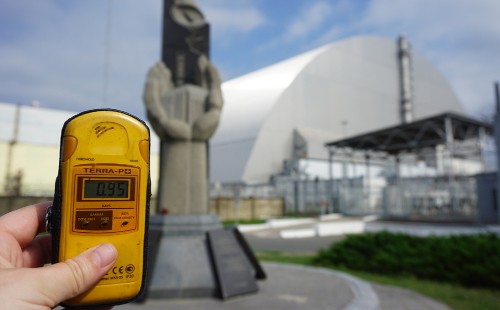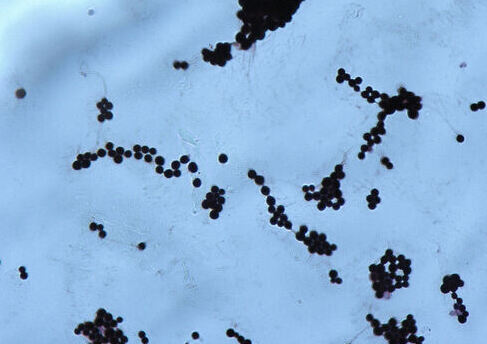Eating gamma radiation for breakfast

Some fungal species appear to be able to use strong radiation as an energy source for growth. Tom Ireland explores the exciting potential of these understudied organisms
In the late 1980s Ukrainian scientists studying the dark, dangerous interior of Chernobyl’s destroyed Reactor 4 found that a black, mould-like fungus was growing across the walls and in pools of radioactive water. The fungus was not just surviving the immense radiation levels in the reactor building, but seemed to be thriving – even growing towards the very highest levels of gamma radiation.
Over the next 15 years thousands of strains of hundreds of different species of microfungi were isolated from in and around the Chernobyl disaster site[1]. In tests many of them grew towards strong sources of ionising radiation and some even appeared able to digest so-called ‘hot particles’ – immensely radioactive graphite from the reactor core itself.
It had been known since the 1960s that certain species of fungi have extremely high resistance to radiation. Fungi had been found growing on the high slopes of Antarctic mountains, where UV levels are among the highest on Earth, and in samples of the water used to cool nuclear reactor cores. But the discoveries at Chernobyl suggested that some fungi seemed to be radiotrophic – actively seeking out and benefiting from high levels of radiation. Could the fungi be using the extremely high-energy gamma radiation as an energy source in the same way that plants use sunlight?
 Cryptococcus neoformans (courtesy of Dr Graham Beards via Wikimedia)
Cryptococcus neoformans (courtesy of Dr Graham Beards via Wikimedia) High exposure
After the initial observational studies by Ukrainian scientists, Professor Ekaterina Dadachova and colleagues at the Albert Einstein College of Medicine in New York decided to investigate these remarkable fungal species in more detail in a series of laboratory experiments. They found that cells of fungi such as Wangiella dermatitidis (now Exophiala dermatitidis) and Cryptococcus neoformans grew significantly faster and accumulated more biomass during exposure to high levels of radiation than when exposed to background levels of radiation[2]. The fungi’s transcriptome and metabolism were significantly altered under the high-radiation conditions[3].
The key to it all seemed to be melanin – the ubiquitous group of pigments found in many types of eukaryote that protect against UV radiation. Dadachova and her colleagues found that when the radiotrophic fungal strains were engineered to have no or little melanin (known as albino mutants) they did not grow better in the presence of ionising radiation.
 The covered remains of reactor 4 at Chernobyl.
The covered remains of reactor 4 at Chernobyl. “For the fungi to grow towards the radiation, you need some kind of very robust sensor that is not destroyed in the process of interacting with that radiation,” says Dadachova. “The radiation is a million times higher energy than the energy of visible light or the energy of a chemical bond. That’s what melanin, by virtue of being such a unique molecule, could do.”
In the species found in the Chernobyl reactors, the heavy pigment forms multiple concentric layers that build into a dark spherical shell. Eroding the other cell material away with strong chemicals leaves dark melanin ‘ghosts’ in the shape of the parent cell[4].
Dadachova and colleagues found that strong ionising radiation changes the electrochemical structure of fungal melanin, increasing its ability to act as a reducing agent[3] and transfer electrons. They began to theorise that melanin was acting not just as a radioprotective shield, but as an energy transducer that could sense and perhaps even harness the energy from the ionising radiation in the same way photosynthetic pigments help harness the energy of sunlight.
“What’s important to say is that when you give a fungus its favourite nutritious media, it has no need to turn on these mechanisms,” says Dadachova. “It will just eat what you give it and it will not start using the ionising radiation – we tested that many times. But if the fungus finds itself in nutrient-deficient conditions – for example, right inside the Chernobyl reactor where there is no rotting vegetation to process – that’s when they switch on that mechanism.”
It’s worth remembering that life on Earth emerged at a time when radiation levels were far higher than they are now. Many fungal fossils show evidence of melanisation, especially in periods of high radiation when many animal and plant species died out, such as during the early Cretaceous, when the Earth temporarily lost its shield from cosmic radiation. Melanised fungi are still common today and many types of edible mushroom contain lots of melanin, including the dark mushrooms used to give earthy, umami flavours in Chinese cooking. Heavily melanised fungi have been found growing on the outside surfaces of the Mir and ISS space stations, which are battered by huge levels of solar radiation.
Melanin masters
So why have fungi become the planet’s melanin specialists? “I think because fungi are eukaryotes, so they are much more complex than other microbes and have to protect the genome, their nucleus,” says Dadachova. “They often live on or in soil, where there are many environmental insults and predators. So the fungi have evolved this sophisticated first line of defence against it all. There are some really severe cases of fungal disease where the fungi have thick layers of melanin in their cell wall and the patient’s immune system can do nothing against them.”
Dadachova’s interest in radiotrophic fungi began during her postdoc studies, when she was studying how radiation affects living cells and the idea of producing therapies based on targeted radiation. One of the targets she and her collaborator Arturo Casadevall identified that could be useful for radio-labelled antibodies was melanin. “The melanin pigment is very widespread in all classes of little things, but microscopic fungi love to make melanin,” she says. “That’s how we sort of became interested in how these black microscopic fungi interact with ionising radiation.”
Her latest work has set out in more detail how previous radiation exposure introduces adaptations to melanised fungal species that equip them to tolerate, sense and respond to radiation byproducts[2].
Now chair of radiopharmacy at the University of Saskatchewan in Canada, Dadachova hopes that in the coming years collaborations between her and biologists from the university’s departments of biology and agriculture can help elucidate the exact mechanism through which fungi use melanin to enhance their growth – in the same way that the various chemical steps of photosynthesis were described in detail by chemists in the 19th and 20th centuries. “My understanding is that, so far, nobody has done this, so that’s my long-term goal.”
 Could radiotrophic and radioprotective fungi help build, protect, and feed colonies in space or on other planets?
Could radiotrophic and radioprotective fungi help build, protect, and feed colonies in space or on other planets?A better understanding of the properties of fungal melanin could lead to interesting applications in a number of areas. Some groups are looking to make synthetic melanins for use as protectorants against UV or other forms of radiation. Others think fungi could find a use in the bioremediation of radioactive waste. Dadachova is particularly interested in how melanin could be used to help protect patients undergoing radiation therapies. She is also working on a collaboration with the Canadian Space Agency and scientists from the Brookhaven National Laboratory on melanin-based spacesuits that could protect astronauts from the effects of radiation in space. (The work has so far involved making tiny melanin helmets to protect the brains of mice.)
Future applications
Then there is the possibility that radiotrophic fungi could help us develop new sources of renewable energy and biomaterials. “There are many places on our planet that experience very [little rain] and where plants are difficult to grow. Could you replace them with plants or fungi that use melanin instead of chlorophyll? Those guys don’t mind being in very dry conditions. And they will probably make the same useful sugars and other things that we take from green plants currently,” says Dadachova. More speculative ideas imagine that these fungi could help protect or even feed space colonists – for example, forming a self-replicating radioprotective building material for a Martian base.
For now, however, this tantalising glimpse of another way life can harness radiation remains poorly understood.
“My conviction is that we need to bring plant biologists into this field, people who know the photosynthetic process inside out,” says Dadachova. “When we start collaborating with those colleagues, then this field can really thrive.”
Tom Ireland MRSB is editor of The Biologist.
References
1) Zhdanova, N.N. et al. Ionising radiation attracts soil fungi. Mycol. Res. 108(9), 1089–1096 (2004).
2) Dadachova, E. et al. Ionising radiation changes the electronic properties of melanin and enhances the growth of melanised fungi. PLoS One 2007(5), e457 (2007).
3) Malo, M.E. et al. Transcriptomic and genomic changes associated with radioadaptation in Exophiala dermatitidis. Comput. Struct. Biotechnol. J. 19, 196–205 (2021).
4) Wang, Y. et al. Melanin, melanin ‘ghosts’, and melanin composition in Cryptococcus neoformans. Infect. Immun. 64(7), 2420–2424 (1996).


